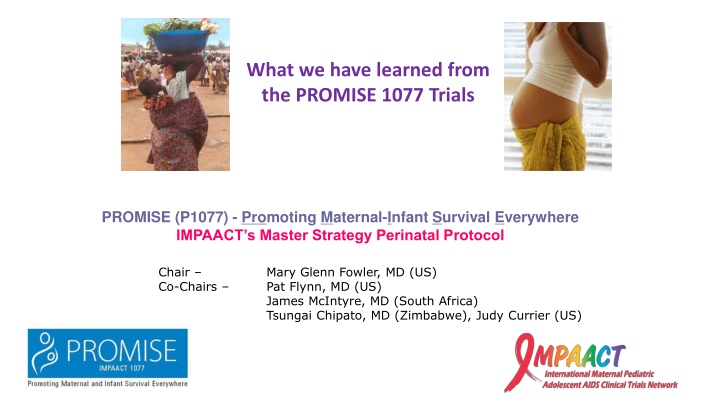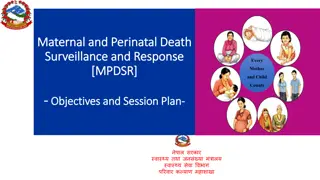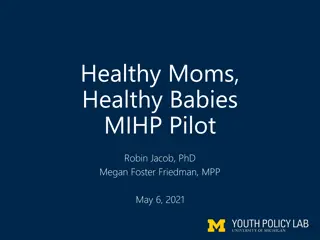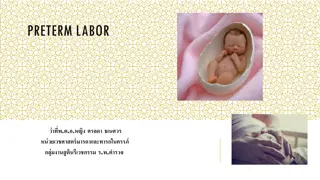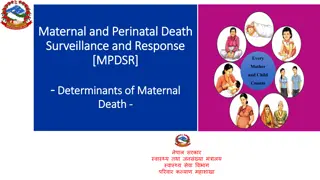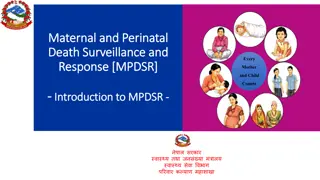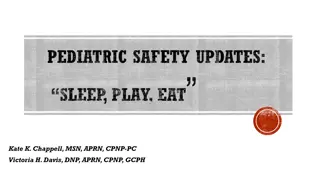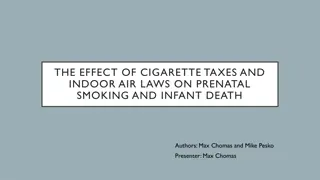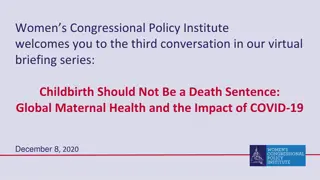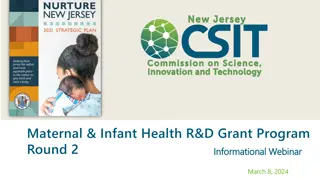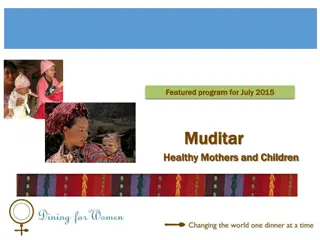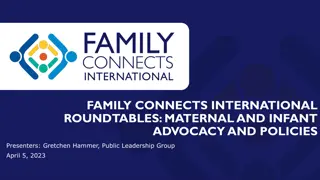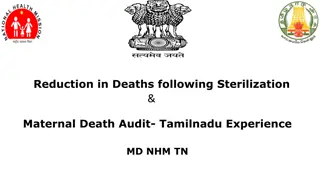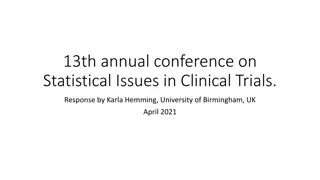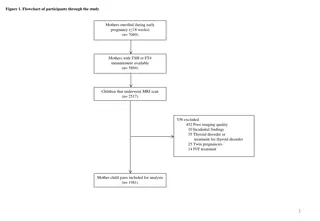Insights from PROMISE 1077 Trials on Maternal-Infant Survival
The PROMISE 1077 Trials focused on key research questions related to the effectiveness and safety of antiretroviral therapy in HIV+ pregnant women, especially concerning maternal ART during antepartum and postpartum stages, as well as the impact on maternal health post-pregnancy. The trials recruited a significant number of participants across various sites and explored different randomizations to evaluate outcomes. Findings from the antepartum component highlighted the importance of triple maternal ARV regimens in improving outcomes for both mothers and infants.
Download Presentation

Please find below an Image/Link to download the presentation.
The content on the website is provided AS IS for your information and personal use only. It may not be sold, licensed, or shared on other websites without obtaining consent from the author.If you encounter any issues during the download, it is possible that the publisher has removed the file from their server.
You are allowed to download the files provided on this website for personal or commercial use, subject to the condition that they are used lawfully. All files are the property of their respective owners.
The content on the website is provided AS IS for your information and personal use only. It may not be sold, licensed, or shared on other websites without obtaining consent from the author.
E N D
Presentation Transcript
What we have learned from the PROMISE 1077 Trials PROMISE (P1077) - Promoting Maternal-Infant Survival Everywhere IMPAACT s Master Strategy Perinatal Protocol Chair Co-Chairs Mary Glenn Fowler, MD (US) Pat Flynn, MD (US) James McIntyre, MD (South Africa) Tsungai Chipato, MD (Zimbabwe), Judy Currier (US)
Background: Primary PROMISE Research Questions Background: Primary PROMISE Research Questions Among HIV+ women with high CD4 counts who did Among HIV+ women with high CD4 counts who did not meet treatment criteria at the time of the trial not meet treatment criteria at the time of the trial Antepartum: Will use of maternal ART be more efficacious and as safe as other proven regimens for PMTCT (ZDV along with sdNVP and TRV tail)? Postpartum, during breastfeeding: Will use of maternal ART be more efficacious and as safe as infant NVP prophylaxis when used to prevent transmission during breastfeeding? Maternal Health: Will continuation of maternal ART after the risk period for MTCT is over, be associated with reduced risk of AIDS or death? AND have no increased risk of toxicities when compared to discontinuing maternal ART?
Time Frame, Numbers Recruited into PROMISE related Trials PROMISE was conducted from 2011-2016 1077 HS: 1612 HIV+ pregnant women at 52 sites in US and internationally where ART was SOC and formula feeding was safe, affordable and recommended 1077 BF: 3245 HIV+ pregnant women at 14 sites in E. and Southern Africa, & India where Breastfeeding and ZDV + sd NVP were SOC 1077FF: 284 pregnant women at 3 sites in S. Africa and India where ZDV + sd NVP were SOC among women who met AFASS and chose FF
1077 Trials: Three PROMISE Randomizations AntepartumLabor/Postpartum Maternal Health (14 wks-term) Delivery (for duration of BF) (after risk of infant 0.56% mART vs 1.87% ZDV 0. 5% ART vs 0.6% iNVP HR 0.68 (95% CI 0.19-2.40) infant uninfected at birth transmission is ended) (Version 2.0) R a n d o m i z e Continue Triple ARV Regimen Triple ARV Prophylaxis R a n d o m i z e Triple ARV Prophylaxis Triple ARV Prophylaxis R a n d o m i z e Mother Stop All ARVs ZDV + sdNVP+ TRV ZDV Infant NVP Prophylaxis Breastfeeding Version Formula Feeding Version Breastfeeding Version Breastfeeding Version Formula Feeding Version HAART Standard
What did we learn from the PROMISE Antepartum Component Findings? Triple maternal ARV (ART) regimens in pregnancy resulted in lower rates of HIV transmission to infants (0.56%) compared to zidovudine plus single dose nevirapine (1.8%). The TDF/FTC and ZDV/3TC ART regimens were significantly associated with higher risk of moderate but not severe adverse pregnancy outcomes including increased risk of: Preterm birth (21% vs 13%) & low birth weight (23% vs12%) which is being followed up to assess their 12 and 24 month infant mortality and HIV-free survival. Increased maternal chemistry grade 2+ toxicities (primary hepatic) There was an increased risk of VPTD and early infant deaths in the TDF-FTC ART arm compared to the 3TC-ZDV ART arm. 5 5
What did we learn from PROMISE about maternal What did we learn from PROMISE about maternal HIV Drug Resistance (DR) and Transmission HIV Drug Resistance (DR) and Transmission? Maternal DR at infant diagnosis was associated with MTCT during breastfeeding but not with in utero/peripartum transmission. After adjusting for maternal HIV RNA load, DR was still significantly associated with increased risk of MTCT (15.8% vs 7.6%) . Infant DR emerged over time possibly due to prolonged exposure to maternal ARV or iNVP prophylaxis or due to ART failure in the infant Poster presented at CROI 2019-- Boyce, Frenkel See upcoming Resistance presentation at Thursday Prevention Scientific Committee meeting by Dr. Boyce for further details
Frequency of Maternal HIV Drug Resistance at Time of Infant Diagnosis Percentage of Mothers with DR Cases Controls 40% p = 0.002 30% p = 0.039 20% 10% p = 0.676 0% n=45 n=123 n=37 n=102 n=82 n=225 IU/Peripartum Breastfeeding Overall Type of Mother-to-Child Transmission
Comparison of Maternal HIV Plasma Viral Load at Time of Infant Diagnosis
What did we learn from the PROMISE Postpartum What did we learn from the PROMISE Postpartum component component findings comparing maternal ART to findings comparing maternal ART to infant NVP during BF? infant NVP during BF? Both maternal antiretroviral therapy (0.5%) and daily infant nevirapine prophylaxis (0.6%) were similar and safe. Both regimens were associated with very low postpartum perinatal transmission rates during extended breastfeeding and high infant survival rates >97%.
In PROMISE What effects did In PROMISE What effects did Maternal ART have on Maternal ART have on infant Growth & Development? infant Growth & Development?
Among infants with VPTD, Were Early Among infants with VPTD, Were Early Infant Deaths related related to to intracellular intracellular Tenofovir Tenofovir Drug Infant Deaths Drug Concentrations? Concentrations? TFV-DP intracellular levels in DBS samples were not significantly different between cases and controls at 4 and 8 weeks post-ART initiation, respectively, and were not associated with individual or composite adverse pregnancy outcomes. These findings, based on data from a limited sample size, suggest that in-utero exposure to TDF-DP concentrations, as measured in DBS, was not significantly associated with the adverse pregnancy outcomes VPTD/ early infant deaths in the PROMISE trial The higher rates of VPTD/early infant deaths among women on TRV ART compared to ZDV/3TC ART remain unexplained. Maternal Prolactin/progesterone levels are being evaluated.
Does Does TDF TDF- - FTC ART adversely effect pediatric FTC ART adversely effect pediatric Growth or Neurodevelopment? Growth or Neurodevelopment? The post partum PROMISE 1084s substudy found that infants born to mothers randomized to maternal TDF ART during breastfeeding had No significant differences in mean LAZ at 26 weeks or other time points BUT Significantly increased risk of stunting (<--2 SD below WHO mean for AGE (HAZ) Z- scores at 26 weeks compared to infants on iNVP OR 1.28 (1.05, 1.57) p=.017 Details to be presented by Dr. Jim Aizire at the Prevention Scientific Committee June 13th A PROMISE co-enrollment R01 study (Fowler, Boivin) in Malawi and Uganda that compared growth of PROMISE HIV exposed Uninfected participants to Unexposed children found that HIV exposed Uninfected PROMISE Children were at significantly increased risk of stunting by 24 months compared to SES/gender matched children born to HIV negative mothers (Azire et al). Adjusted RR stunting Uganda for HEU children was aRR 1.7 (95% CI 1.2-2.4) Adjusted RR stunting Malawi HEU children was aRR 1.3 (95% CI 1.1-1.7) However HEU children had NO increased risk of lower cognitive scores by age 48-60 months with ARV exposures antepartum or post partum (Boivin et al, in press Lancet HIV)
Boivin/Fowler ND grant: Risk of stunting for HEU PROMISE Boivin/Fowler ND grant: Risk of stunting for HEU PROMISE Children in Malawi and Uganda versus HUU children Children in Malawi and Uganda versus HUU children Jim Jim Azire Azire et al, IAS 2017 et al, IAS 2017 Risk of stunting (LAZ < -2 SD) Controls Exposed P=0.248 60 P=0.341 48.4% 50 STUNTED (LAZ <-2 SD, (%)) 42.7% P=0.001 40.4% P<0.001 40 35.6% 32.2% 29.8% 30 18.2% 20 13.3% 10 0 Malawi Uganda Malawi Uganda 12 MONTHS 24 MONTHS 13
Boivin et al, IAS 2018 Malawi - Mullen Scales of Early Learning Cognitive Composite Standard Score Uganda - Mullen Scales of Early Learning Cognitive Composite Standard Score Distribution of standard Distribution of standard Distribution of standard Distribution of standard 140 140 F 1.77 F 1.34 Prob > F 0.1341 Prob > F 0.2543 100 100 120 120 standard standard standard standard 100 100 80 80 80 80 60 60 60 60 Triple ARV+Infant NVP Triple ARV+Infant NVP Triple ARV+Maternal triple ARV Triple ARV+Maternal triple ARV ZDV+Infant NVP ZDV+Infant NVP ZDV+Maternal triple ARV ZDV+Maternal triple ARV zUnexposed controls zUnexposed controls Triple ARV+Infant NVP Triple ARV+Infant NVP Triple ARV+Maternal triple ARV Triple ARV+Maternal triple ARV ZDV+Infant NVP ZDV+Infant NVP ZDV+Maternal triple ARV ZDV+Maternal triple ARV zUnexposed controls zUnexposed controls 48 Months 48 Months r_arm r_arm r_arm r_arm Mullen Cognitive Composite Standardized Score Mean 76.84 Mullen Cognitive Composite Standardized Scores Mean 84.62 Level of Ante- Partum and Post- Partum ARV Exposure Treatment Arms Triple ARV+Infant NVP Level of Ante- Partum and Post- Partum ARV Exposure Treatment Arms Triple ARV+Infant NVP N Std Dev 12.13 N Std Dev 15.01 44 42 36 83.03 12.65 Triple ARV+Maternal triple ARV 52 87.73 16.13 Triple ARV+Maternal triple ARV 34 81.71 11.56 ZDV+Infant NVP 39 87.72 14.39 ZDV+Infant NVP 37 81.35 11.74 ZDV+Maternal triple ARV 36 80.94 14.11 ZDV+Maternal triple ARV 191 82.32 12.99 Unexposed controls 179 85.73 15.29 Unexposed controls
WHAT IMPACT DID MATERNAL ART HAVE ON MOTHERS HEALTH DURING FOLLOW UP IN PROMISE?
PROMISE 1084s: Were there effects PROMISE 1084s: Were there effects of postpartum Maternal ART have on of postpartum Maternal ART have on Maternal Bone Density? Maternal Bone Density? Post partum Maternal TDF based ART was associated with significantly Hip and Lumbar-Sacral spine bone mineral density compared to women randomized to no ART whose infants received infant NVP during Breastfeeding. Stranix et al. IAS 2016
1084s TDF ART versus Lumbar 1084s TDF ART versus Lumbar spine BMD % decline week 1 to 74 greater in maternal ART study arm week 1 to 74 greater in maternal ART study arm spine BMD % decline Mean difference of -2.86% (-4.03, -1.70) (p-value <0.001) No maternal ART N=168 +0.81% (-0.01, +1.64) Maternal Triple ART N=169 -2.05% (-2.88, -1.22) Mean % change (95% Confidence Interval ) 17
What did we learn from the PROMISE Maternal Health What did we learn from the PROMISE Maternal Health Component on the Benefits or Risks of Continuing Component on the Benefits or Risks of Continuing ART after the period of risk of MTCT is over? ART after the period of risk of MTCT is over? During PROMISE Follow up, Risk of Progression to AIDS or death events was extremely low There were no significant differences between continuing or discontinuing maternal ART in either 1077HS (Hoffman et al, Clinical trials, 2018) or the 1077 BF/1077FF Maternal Health component There was however an significantly increased risk of progression to WHO clinical grade 2-3 events in 1077HS and similar trend in 1077BF/1077FF In subsequent pregnancies, when conception occurred while mothers were on ART, there was increased risk for adverse pregnancy outcomes including abortions and still births. Similar to finding from several programs in other African settings.
PROMISE 1077HS FOUND NO SIGNIFICANT DFFERENCES IN PROMISE 1077HS FOUND NO SIGNIFICANT DFFERENCES IN PROGRESSION TO AIDS OR DEATH FOR WOMEN RANDOMIZED TO PROGRESSION TO AIDS OR DEATH FOR WOMEN RANDOMIZED TO STOP OR CONTINUE ART AFTER RISK FOR STOP OR CONTINUE ART AFTER RISK FOR PMTCT PMTCT WAS OVER WAS OVER Hazard ratio 0.48 (95% CI 0.33, 0.70) Event rate lower than expected Hazard ratio 0.68 ( 95% CI 0.19, 2.40) Occurrence of AIDS-defining illness, serious non-AIDS defining cardiovascular, renal or hepatic event or death Occurrence of unexplained weight loss, zoster, recurrent RTIs or oral ulcerations, targeted rashes, chronic diarrhea, oral candidiasis, pulmonary TB, etc
PROMISE 1077BF/FF found Similar Findings Among Women in PROMISE 1077BF/FF found Similar Findings Among Women in Low Low- -Income Countries (1077 FF/BF): NO significant differences in Income Countries (1077 FF/BF): NO significant differences in Risk of AIDS or Death for continuing or stopping ART Risk of AIDS or Death for continuing or stopping ART
Does Does maternal ART exposure at conception maternal ART exposure at conception increase risk of Adverse of Adverse Pregnancy Pregnancy Outcomes? 1077HS and 1077BF Outcomes? 1077HS and 1077BF post hoc analyses of subsequent pregnancy outcomes post hoc analyses of subsequent pregnancy outcomes Adverse Pregnancy outcomes 1077HS and 1077BF MH component increase risk Summary of Relative Risks and Hazard Ratios 1077HS and 1077BF MH In 1077HS, When spontaneous abortions and stillbirths were combined, there was a significant difference in events, with 33/140 (23.6%) in the CTART arm versus 15/126 (11.9%) in the DCART arm (relative risk[RR], 2.0 [95% confidence interval {CI}, 1.1 3.5]; P = .02). (R Hoffman, et al, CID 2019) In 1077BF, similar results were seen: The intent to treat analyses showed significantly increased low birth weight in the Maternal Health continue ART group. See Presentation at Thursday Prevention SC by Theron et al for details 35% 30% 25% 20% 15% 10% 5% 0% 1077HS AB SB 1077Bf % LBW % LBW after BF Cont ART Discontinue ART
Overall Conclusions: We learned and are Overall Conclusions: We learned and are continuing continuing to learn a lot from PROMISE! to learn a lot from PROMISE! Maternal ART is highly efficacious in reducing risk of MTCT with rate of <1% during antepartum, Labor/delivery and Breastfeeding Maternal ART is also associated with some adverse effects including increased risk of moderate adverse pregnancy outcomes Both maternal ART and infant NVP are similarly efficacious in reducing risk of transmission to <1% during BF Maternal resistance mutations are associated with increased risk of transmission during BF We found no differences for women randomized to continue or stop ART after the risk of MTCT was over in terms of maternal AIDS or death events; but there was less risk of progression to WHO clinical state 2-3 with ART continuation TDF-FTC ART post partum was associated with significantly lower BMD at 74 weeks than mothers not randomized to ART post delivery
PROMISE Related Publications Pub or Accepted PROMISE Related Publications Pub or Accepted Fowler MG, Qin M, Fiscus SA, Currier JS, Flynn PM, et al for the IMPAACT 1077BF/1077FF PROMISE study team. Benefits and risks of Antiretroviral Therapy for Perinatal HIV Prevention. New England Journal of Medicine, 2016. 375(18): p. 1726-1737. PMC5214343. Hoffman R et al. Maternal health outcomes among HIV- infected breastfeeding women with high CD4 count: results of a treatment strategy trial. Accepted to HIV Clinical Trials in October 2018. (PROMISE tracking number, MH-1) (Shepherd JA, Sommer MJ, Fan B, et al. Advanced Analysis Techniques Improve Infant Bone and Body Composition Measures by Dual-Energy X-Ray Absorptiometry. The Journal of Pediatrics. Feb 2017;181:248-253.e243. PMC5274603 Boivin M et al. Developmental effects of antepartum and postpartum ARV exposure for Ugandan and Malawian PROMISE HIV-exposed versus unexposed children at age 12, 24, 48, and 60 months. Accepted Lancet HIV in March 2019. (PROMISE tracking number, CO-5-a) Currier JS, Britto P, Hoffman RM, Brummel S, et al. Randomized trial of stopping or continuing ART among postpartum women with pre-ART CD4 400 cells/mm3. PLoS One. 2017 May 10;12(5):e0176009. PMC5425014 Murnane P et al. Tenofovir concentrations in hair strongly predict virologic suppression in breastfeeding women. Accepted to AIDS in March 2019. Sebikari D et al. Risk Factors for Low Birth Weight (LBW) and Preterm Delivery (PTD) in the IMPAACT PROMISE- 1077BF Randomized Trial. Accepted to JAIDS in March 2019. Flynn PM, Taha TE, Cababasay M, et al Prevention of HIV-1 transmission through breastfeeding: efficacy and safety of maternal antiretroviral therapy versus infant nevirapine prophylaxis for duration of breastfeeding l. JAIDS. 11 Dec 2017. ePub ahead of print. 2018 Apr 1;77(4):383-392. PMC5825265. Also PROMOTE PEPFAR COHORT Taha/Fowler And three related R01 grants: ND, Growth and Development: Boivin/Fowler Maternal DXA Repeat Pregnancy: Fowler Brain Computer Games-- Boivin Hoffman RM, Brummel SS, Britto P, Pilotto JH,. Klingman KL, Currier JS; 1077HS PROMISE Team. Adverse Pregnancy Outcomes Among Women who Conceive on Antiretroviral Therapy. Clin Infect Dis. 1 Jun 2018. ePub ahead of print. Jan 2019;68(2):273-9. PMC6321847.
Pending PROMISE Analyses and Further Pending PROMISE Analyses and Further Research Needed Research Needed Antepartum Component: Further basic research on the biologic basis for the increased risk of adverse pregnancy outcomes with ART Assess the role of breast milk viral load and resistant mutations in breastmilk in relation to infants who became infected Follow up of 12 and 24 month overall and HIV free survival including for preterm and low birth weigh infants Further research to better understand growth findings related to stunting among HIV Exposed but Uninfected children Assessment of later school performance among HEU children Follow up of Maternal Bone Health including Maternal Bone Mineral Density decreases after cessation of breastfeeding and impact of repeat pregnancy among HIV + mothers on lifetime ART
Thank you for your attention and Thank you for your attention and we welcome your help with we welcome your help with future future PROMISE Analyses PROMISE Analyses! !
Acknowledgements: The PROMISE team Acknowledgements: The PROMISE team gratefully acknowledges the support of gratefully acknowledges the support of All the mothers and infants who participated in the 1077 PROMISE trials The Co Chairs and Component leaders, Site IoRs and the staff at the PROMISE sites The IMPAACT Central Lab, SDAC, FSTRF, and FHI360 staff IMPAACT Leadership The pharmaceutical companies: AbbVie, Gilead, Boehinger Ingelheim, Bristol Meyer Squibb, Merck, GlaxoSmithKline/ViiV Healthcare The National Institutes of Health: NIAID, NICHD, NIMH
